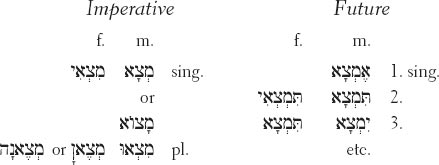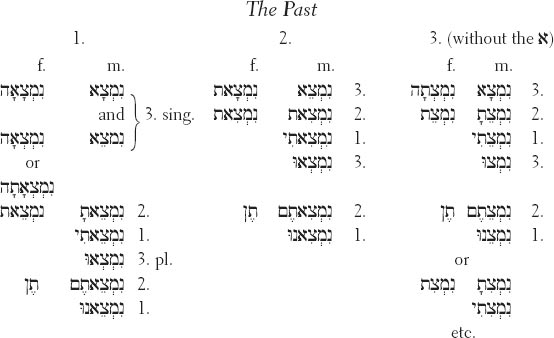 )
) )
)We have said that these verbs of the second conjugation are the verbs which end in an a, namely in a guttural and quiescent letter. Wherein these differ from verbs of the first conjugation will be shown by the paradigm.
The forms of the infinitive are  , or with the paragogic
, or with the paragogic  , and also
, and also  in place of
in place of  .
.

The form  does not appear here, and on that account the second
does not appear here, and on that account the second  and tsere are retained in the remaining persons and not changed to patach as in verbs of the first conjugation. Further, the form
and tsere are retained in the remaining persons and not changed to patach as in verbs of the first conjugation. Further, the form  is not found in the past and I believe it is not used. Finally, in the second and third forms the
is not found in the past and I believe it is not used. Finally, in the second and third forms the  is mainly omitted, like
is mainly omitted, like  in place of
in place of  I am full.
I am full.

The imperative with paragogic  does not change the sheva into a chirek, as in verbs of the first conjugation, but it remains together with the kametz, making it instead of
does not change the sheva into a chirek, as in verbs of the first conjugation, but it remains together with the kametz, making it instead of  into
into  (you) find. These facts together with what we have noted above about the past, are the peculiarities of this verb form; for the rest it agrees with the verbs of the first conjugation. Let me now go into the paradigm of the passive verb of this conjugation.
(you) find. These facts together with what we have noted above about the past, are the peculiarities of this verb form; for the rest it agrees with the verbs of the first conjugation. Let me now go into the paradigm of the passive verb of this conjugation.


The imperative and the future agree in everything with the imperative and future of the first conjugation. Further, the remaining verbs of this conjugation differ from the verbs of the first in the same way as we see these two  and
and  differ from
differ from  and
and  ; namely that instead of a patach, a kametz is inserted in every place, but in its place a chirek is substituted in the second and first persons; except in
; namely that instead of a patach, a kametz is inserted in every place, but in its place a chirek is substituted in the second and first persons; except in  where the chirek in the first and second person changes to tsere, like
where the chirek in the first and second person changes to tsere, like  , etc.; and also that the tsere is always retained and not changed into a patach, like
, etc.; and also that the tsere is always retained and not changed into a patach, like  and finally that the
and finally that the  may also be omitted.
may also be omitted.

1. [Term not used by Spinoza.—M.L.M.]